イミグレーション・ミュージアム・東京×芸術家と子どもたち
ワークショップ&展覧会「家族をつなぐもの」
Immigration Museum Tokyo (IMM) & Children Meet Artists Collaboration Project
Workshop & Exhibition “What Connects Families”
イミグレーション・ミュージアム・東京×芸術家と子どもたち
ワークショップ&展覧会「家族をつなぐもの」
Immigration Museum Tokyo (IMM) & Children Meet Artists Collaboration Project
Workshop & Exhibition “What Connects Families”
2025.1.12
「わたしたちを自由にする線/Lines that Free us」
アーサー・デ・オリベイラ/Arthur de Oliveira
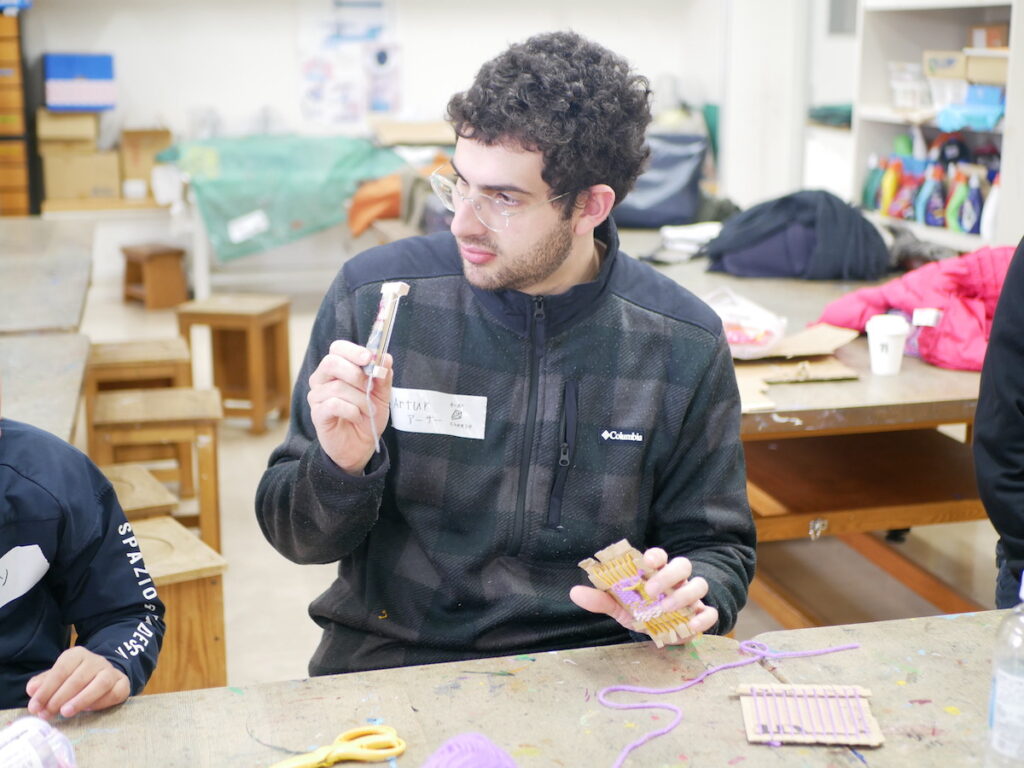
©NPO法人 芸術家と子どもたち
アーサー・デ・オリベイラさんは東京を拠点に活動するブラジル人アーティスト、詩人、映像作家、舞踏家、舞台芸術家です。彼は、異国の生活を「織り」に例えました。それぞれの個人が持つ文化背景は垂直線(経糸)、そして新しい経験は水平線(緯糸)とし、この二本の線を交差させながら、私たちは日々の生活を織り成していると考えたのです。
ワークショップでは、はじめに、子どもたちに各自専用の小さな「ポケット織機」を作るよう促しました。次に、自身の記憶にある母国と現在の環境をそれぞれイメージするために、子供たちは近くの公園で、手作りのノートを使い、遊びながら興味の対象を自覚していきました。この体験をもとに、それぞれの織機を使って布を織りました。誰もが簡単に作れる規則的に溝を切った厚紙の織機のほか、日用品やアラブ首長国連邦のお土産なども使用して布を織りあげました。展覧会では、それらの織機と織り上げた布を一組の作品として展示しました。
Arthur de Oliveira is a Brazilian artist, poet, filmmaker, butohist, theater maker based in Tokyo. He likens life in a foreign country to weaving. He believes that we weave our daily lives by mixing our cultural backgrounds as vertical lines (warp threads) and new experiences as horizontal lines (weft threads). In the workshop, the children were first encouraged to make their own small “pocket looms”. Next, the children went to a nearby park and used their handmade notebooks to search, think, and play to imagine their own memories of their home countries and their current environment, and based on these experiences, they each wove cloth on a small loom.
They used cardboard looms with regularly cut grooves that anyone can easily make, as well as everyday items and souvenirs from the United Arab Emirates to weave the cloth. In the exhibition, the looms and the woven cloth were displayed as a set.
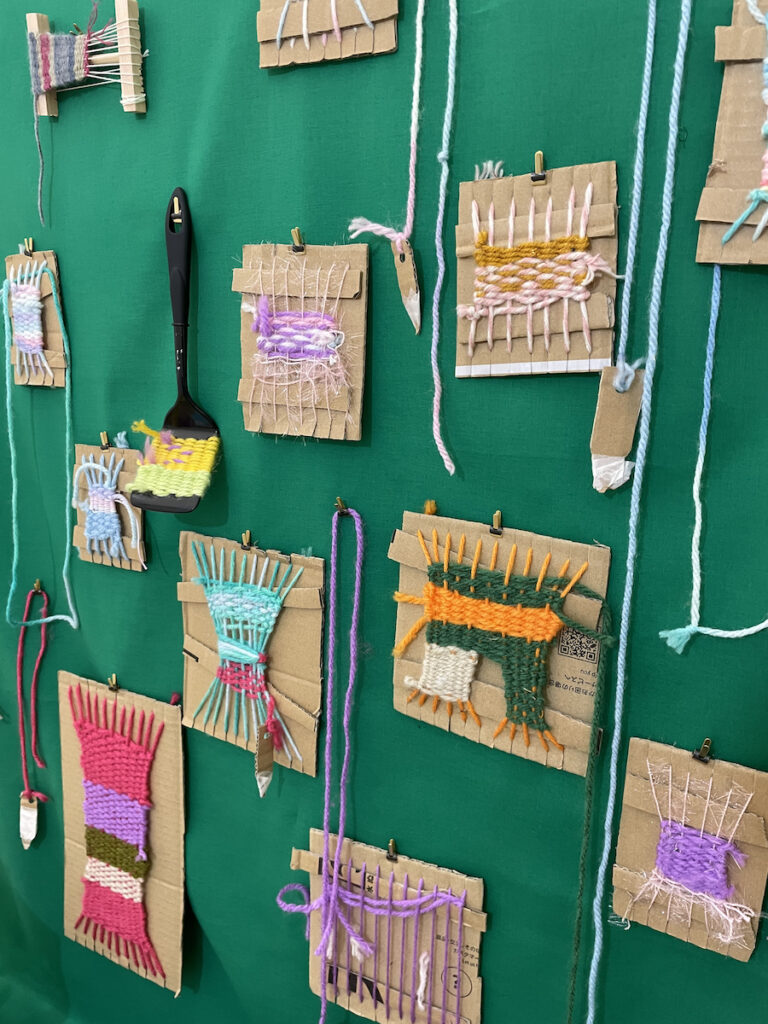
展示作品
Exhibited works
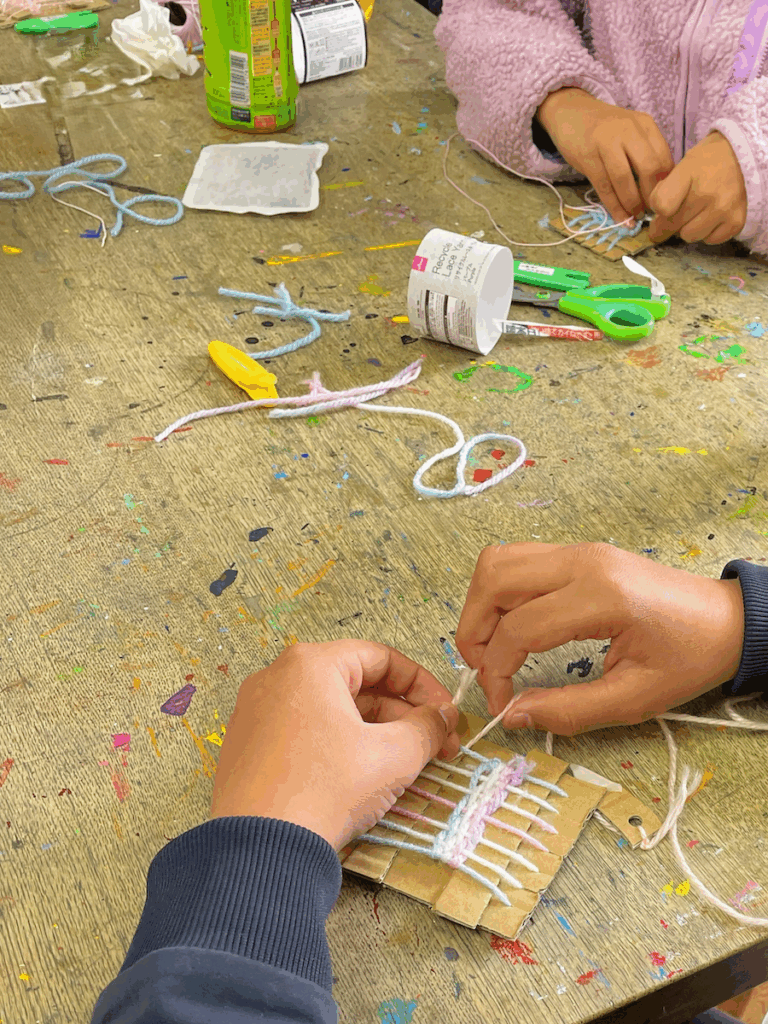
段ボール紙の織機で布を織る
Weaving cloth on a cardboard loom.
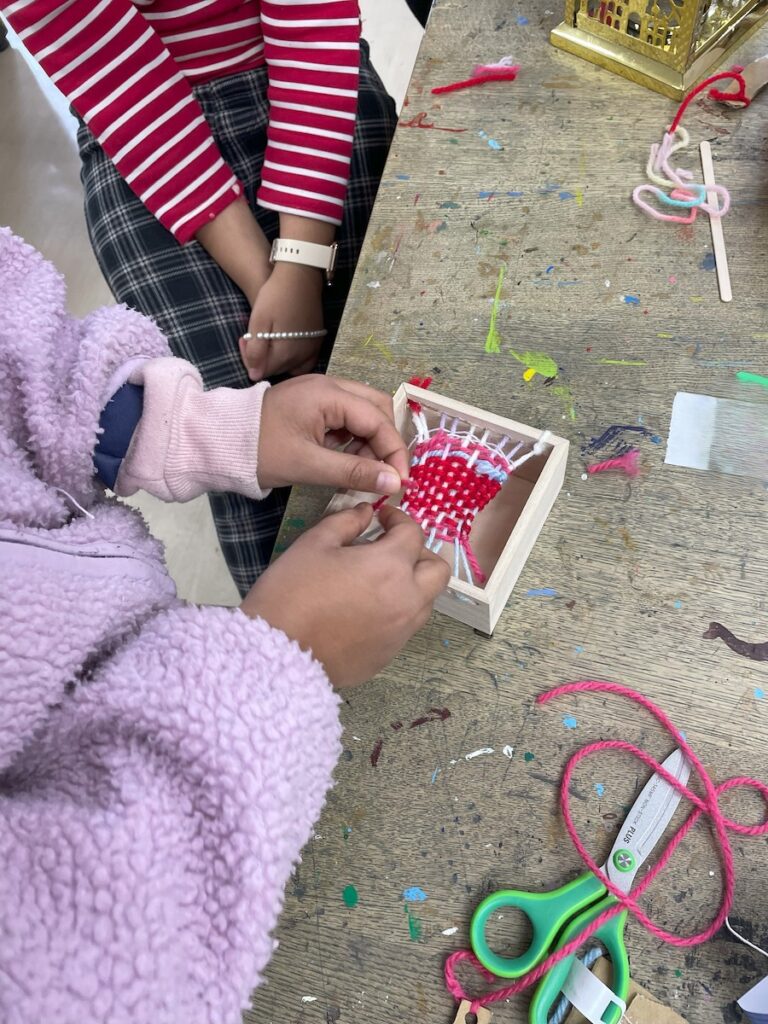
日用品もユニークな織機として使用
Daily items used as unique looms.
2025.1.19
「ペーパー・クイリング/ Paper Quilling」
リスカ・アプサリ/Riska Hapsari
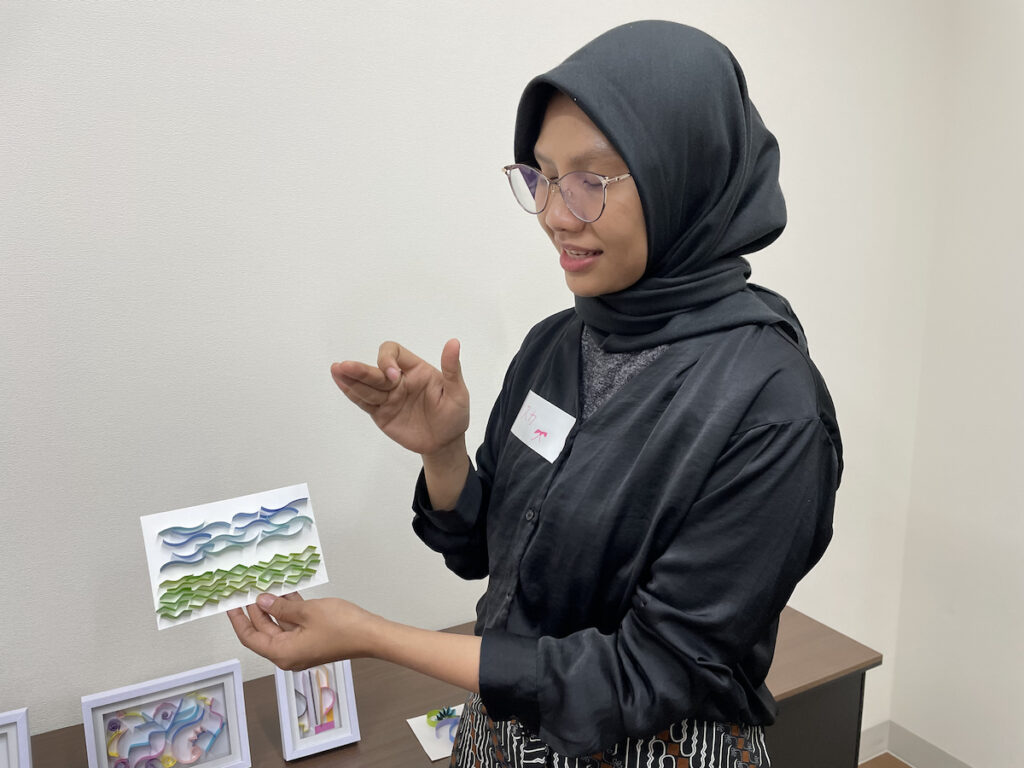
インドネシア出身で日本に住んで7年になるリスカ・アプサリさんは横浜の企業に勤める一児の母です。彼女のワークショップで子どもたちは、16世紀に欧州で生まれた技法「ペーパー・クイリング」を体験しました。はじめに、子どもたちに母国と日本について色のイメージについて考えさせました。それから細い紙を巻いて細かいデザインを作りますが、複雑な形ではなく、色のグラデーションに焦点を当てるように促しました。子どもたちの作品を前にリスカさんは「子どもたちは勇敢で創造的で粘り強く、思い描いた通りの美しいデザインを作りました。子どもたちの創造性が開花するのを見るのは刺激的でした!」と感想を述べています。
Riska Hapsari is a mother of one who has been living in Japan for seven years from Indonesia and works for a company in Yokohama. In her workshop, children learned “paper quilling,” a technique that originated in Europe in the 16th century. First, she asked the children to think about color images of their home countries and Japan. They then rolled thin strips of paper to create intricate designs, encouraging them to focus on color gradations rather than complex shapes. In front of the children’s work, Riska commented, “The children were brave, creative and persistent, and they made beautiful designs exactly as they imagined them. It was inspiring to see the children’s creativity blossom!”
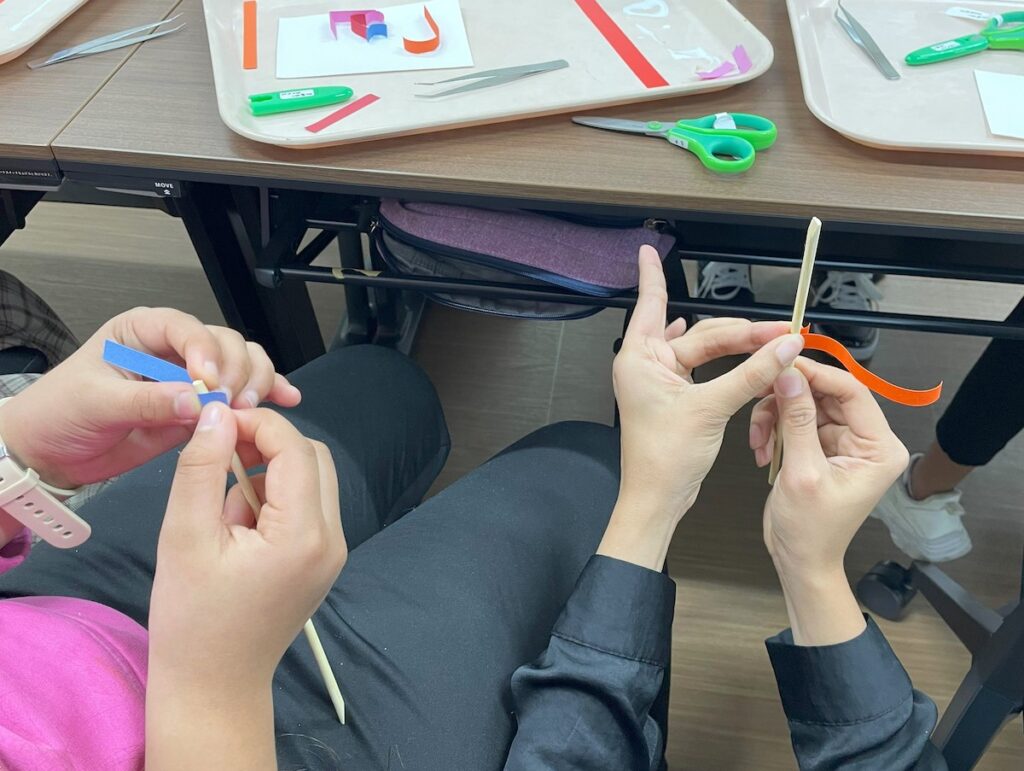
.
裁断した紙をカールさせます
Curl the cut paper
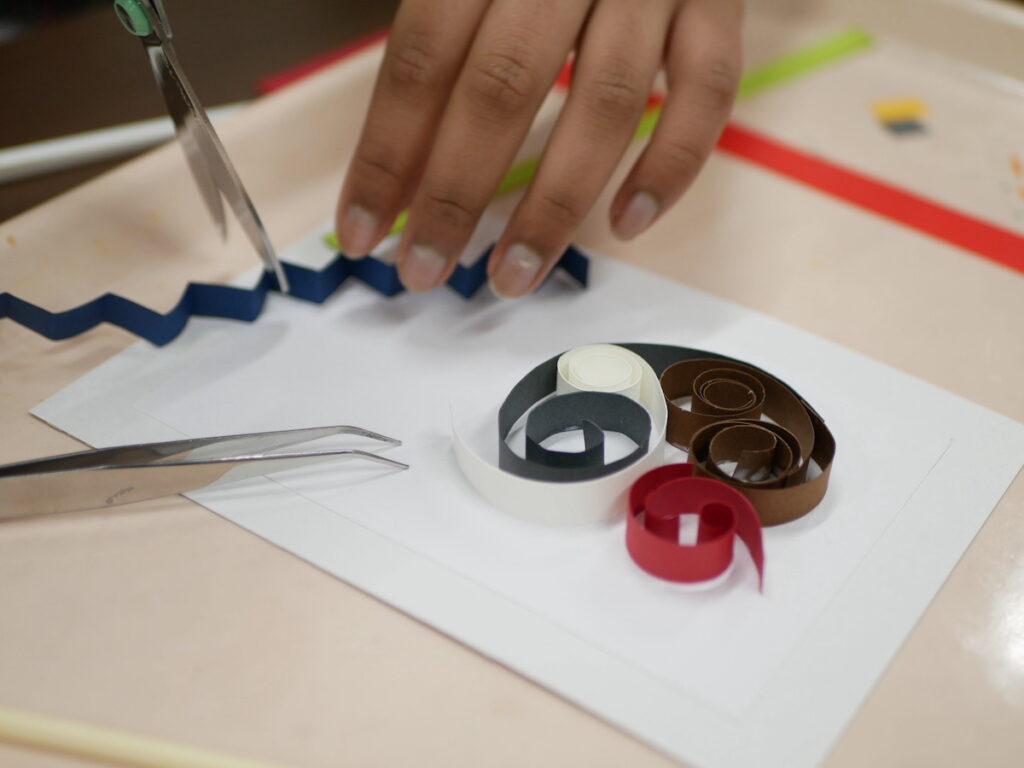
©NPO法人 芸術家と子どもたち
構成しながら台紙に接着剤で留めます
Attach your composition on the mat with glue
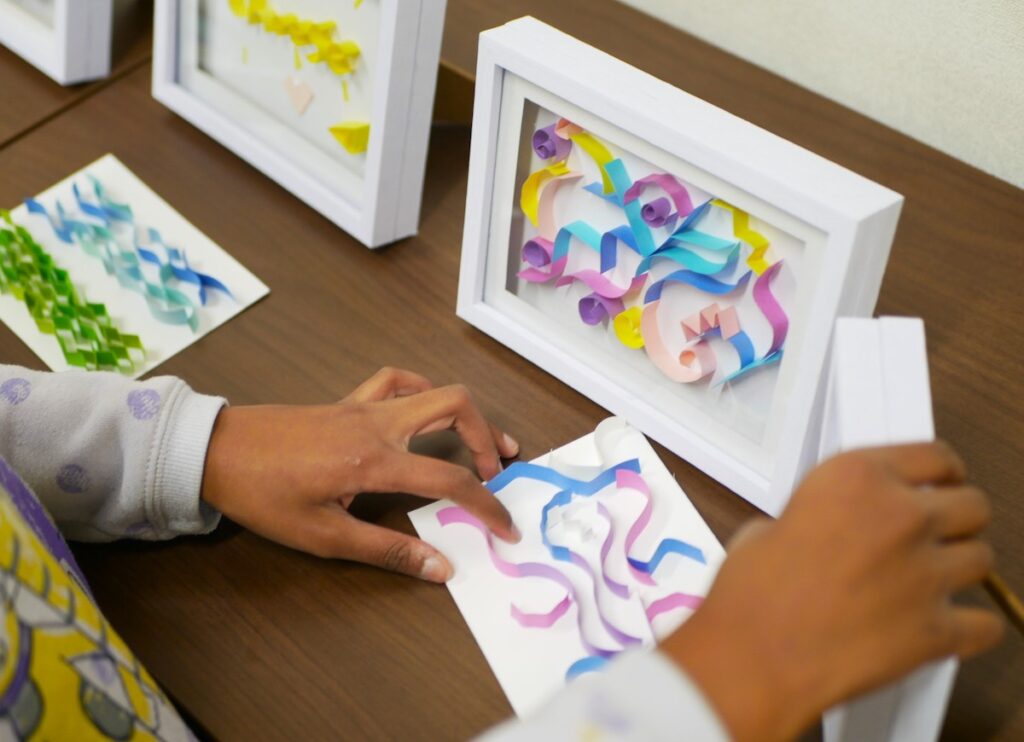
©NPO法人 芸術家と子どもたち
フレームに入れます
Frame the works
2025.1.25
「ミニ・ミーとインナー・ミー/Mini-Me Inner-Me」
キャロライン・サトウ/ Caroline Sato

オーストラリア出身のキャロライン・サトウさんは、日本人の夫とともに、3人の子どもたちを複数の国で育ててきました。アイデンティティというテーマは、彼女がさまざまな国の規範と生き方を調和させていく中で、毎日身近に存在するといいます。このワークショップでは、子どもたちが自分の感覚を物理的な形として表現し、さらに目に見えない側面、つまり自分の内面を反映させるための活動を行いました。子供たちは自分を模した小さな人形=Mini-Meをつくると共に、自身の知られざる背景や秘密の経験についての絵を描きました。その絵を箱のように折り、人形が暮らす空間=Inner-Meとして表現しました。興味深いことに、その絵を箱にすることを選ばずに広げて展示する子どももいました。
Caroline Sato, originally from Australia, has raised her three Japanese-born children in different countries with her Japanese husband. She says the theme of identity is close to her every day as she reconciles the norms and ways of life of different countries. The workshop included activities that allowed children to express their sense of self in a physical form and to reflect on the invisible side of themselves: their inner selves. The children created a small doll, Mini-Me, that resembled themselves and drew a picture of their unknown background or secret experience. They folded the picture into a box, representing the space the doll inhabits as Inner-Me. Interestingly, some children chose not to make the picture into a box, but instead displayed it unfolded.
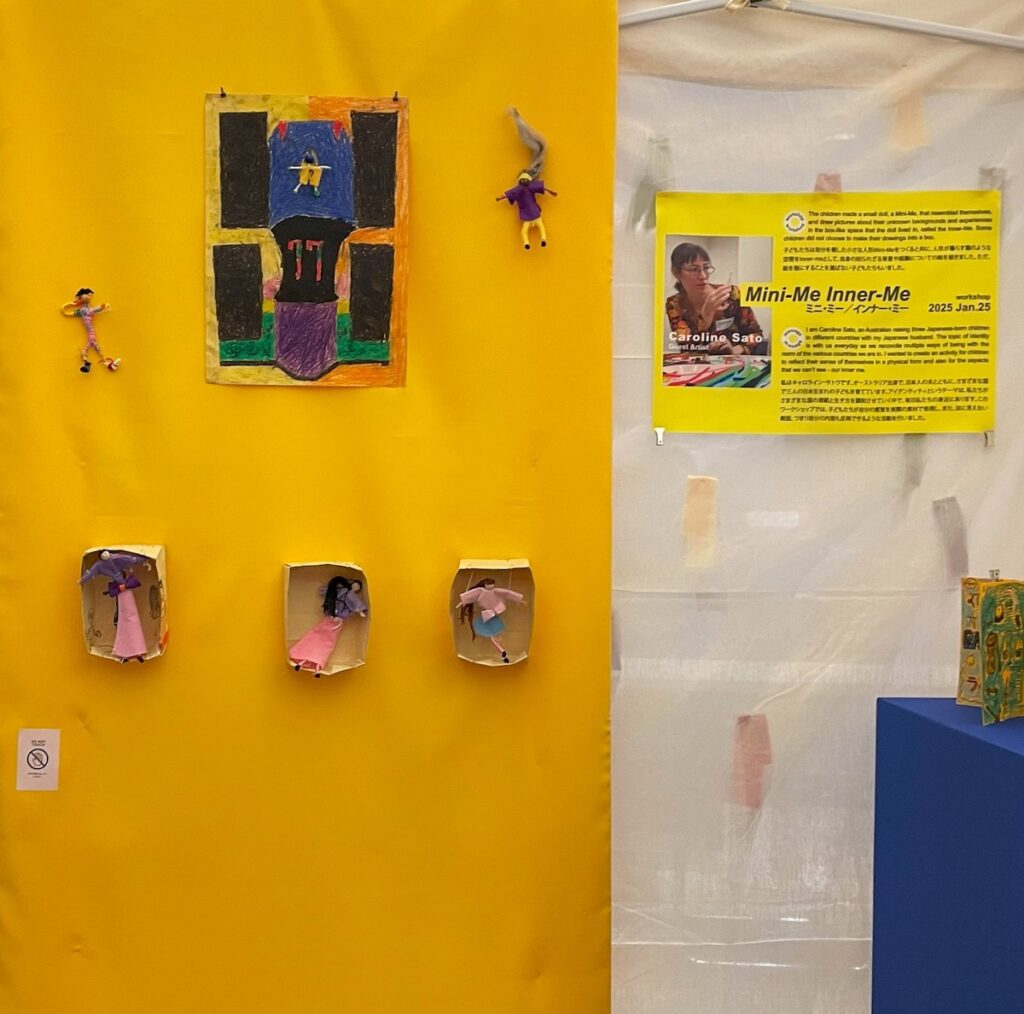
©NPO法人 芸術家と子どもたち
展示風景
Exhibition view
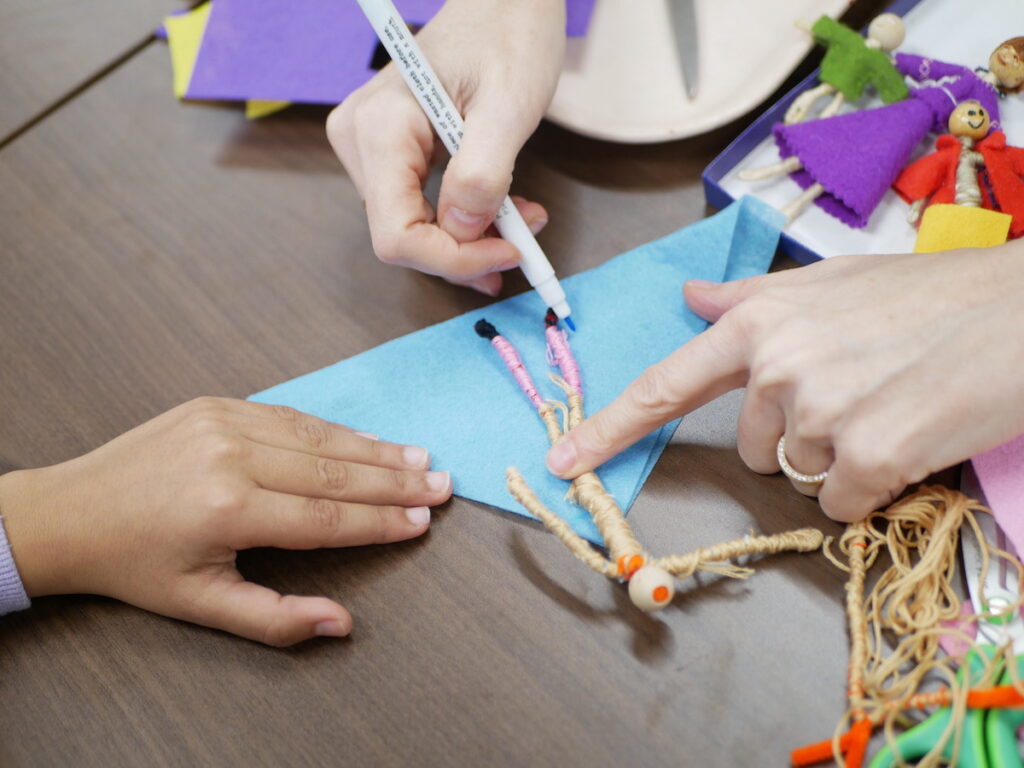
©NPO法人 芸術家と子どもたち
Mini-Meを作る
Making Mini-Me
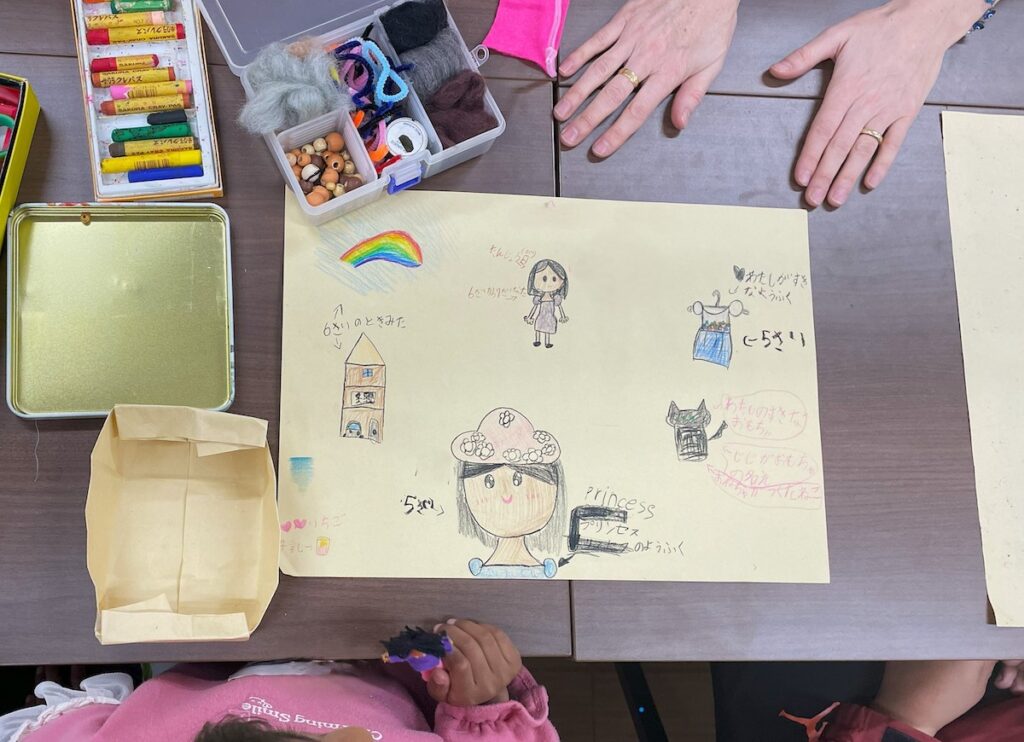
.
Inner-Meを描く
Drawing Inner-Me
2025.2.9
「ルーツとルート〜Zine作りワークショップ/Roots & Routes – A Zine Workshop」
ガオ・ズシン/Gao Zijin
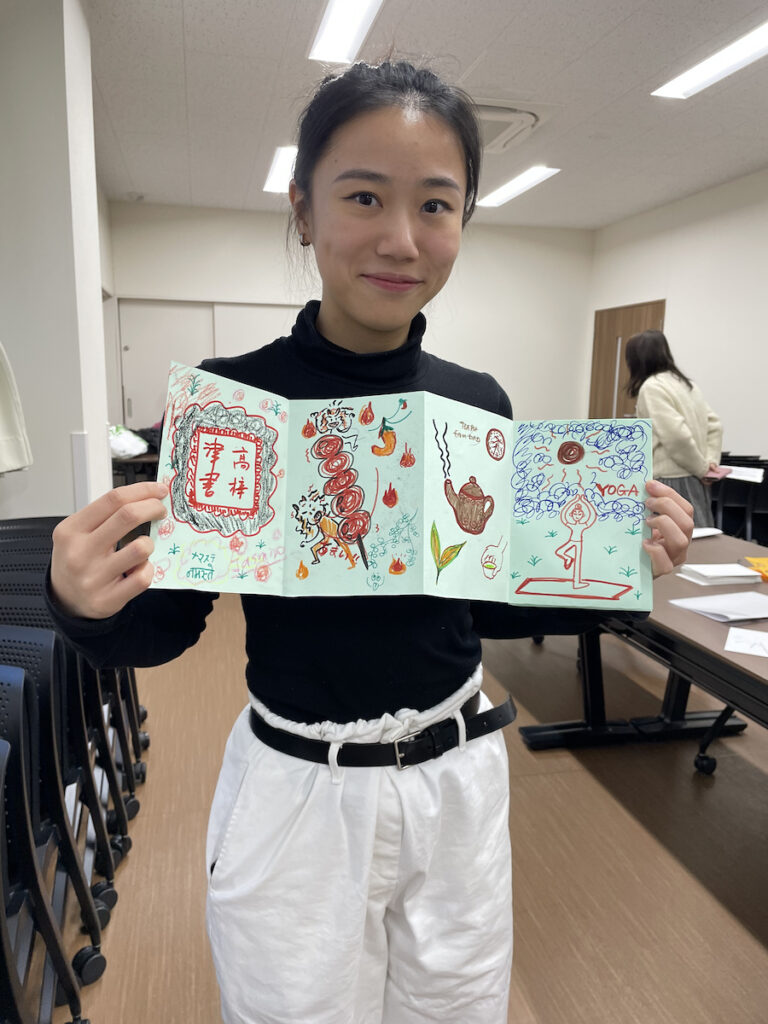
中国、重慶市出身のガオ・ズシンさんは東京を拠点に活動するデザイナー兼アーティストです。彼女は、故郷を離れて暮らすことで、ルーツは出生地だけにとどまらないことを知ったといいます。それは出会う人々や経験する場所によって形作られるというのです。ガオさんは、このワークショップを通じて、普段あまり話されない質問をきっかけに家族の対話を促し、私たちのルーツは身近な人々の中にあり、それが成長を支え導いてくれることを伝えたいと考えました。はじめに子供たちは、Zine(=小さな冊子)を半分完成させるために四つの質問に対して絵や文章で回答します。そして、子どもたちがZineを家に持ち帰り、子どもたちの回答に対して両親または家族の一員がレスポンスを記すことでジンを完成させました。一方で、多忙な両親にワークショップへの関心を促すことの難しさも課題として残りました。
Gao Zixin, originally from Chongqing, China, is a designer and artist based in Tokyo. Living away from her hometown, she learned that roots are not limited to the place of birth. They are shaped by the people you meet and the places you experience. Through this workshop, Gao wanted to encourage family dialogue by asking questions that are not often discussed, and to convey that our roots are in the people closest to us, and that they support and guide us as we grow. First, the children answered four questions with pictures or writing to half-complete a zine (a small booklet). The children then took the zine home, and their parents or family members wrote responses to the children’s answers to complete the zine. Another challenge remained the difficulty of getting busy parents interested in the workshops.
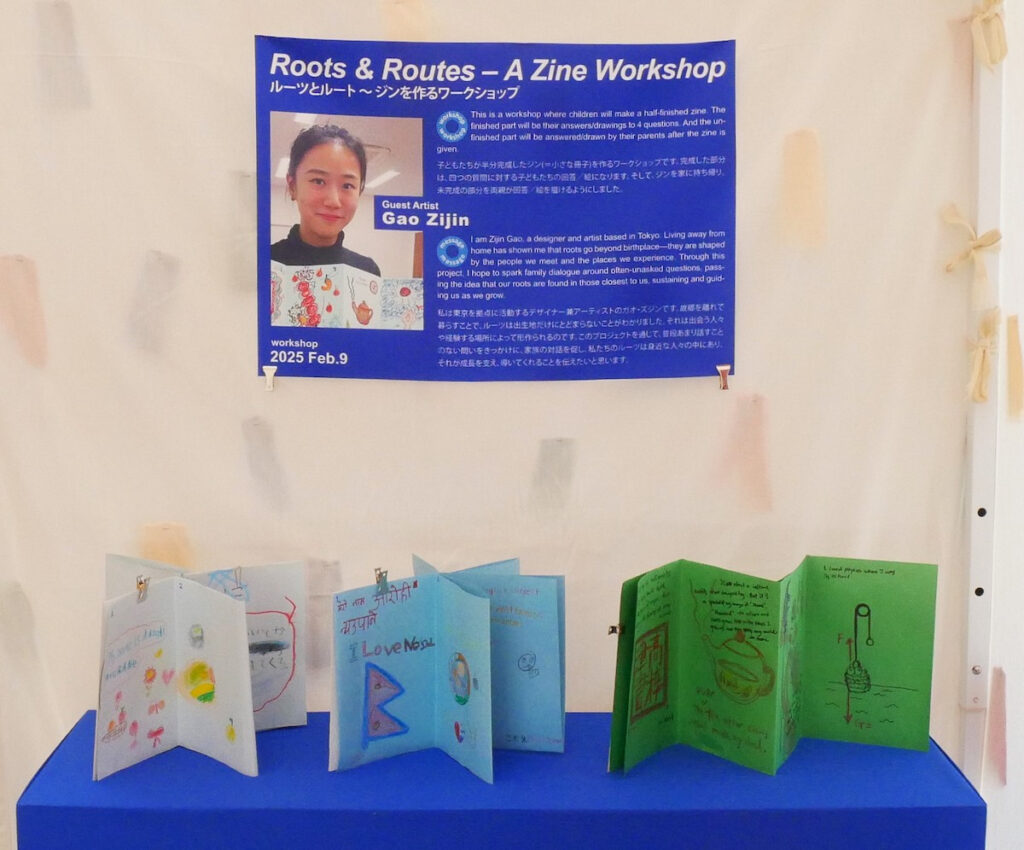
©NPO法人 芸術家と子どもたち
展示風景
Exhibition view
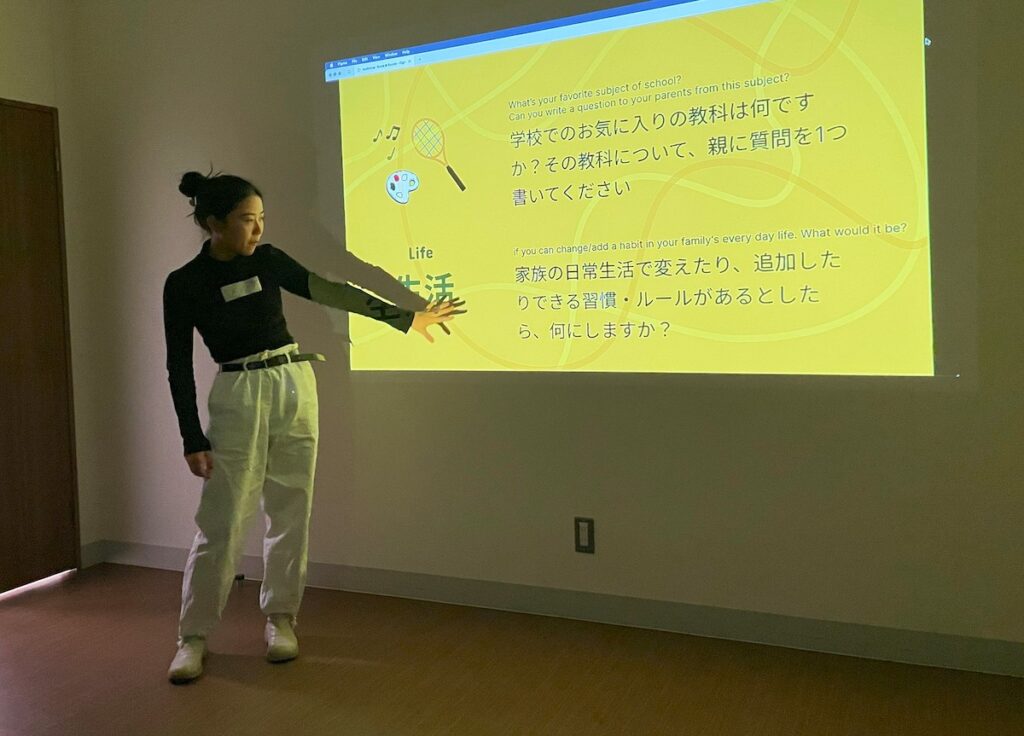
.
子どもたちと家族への質問を解説するズシンさん
Zijin explaining questions to children and their families
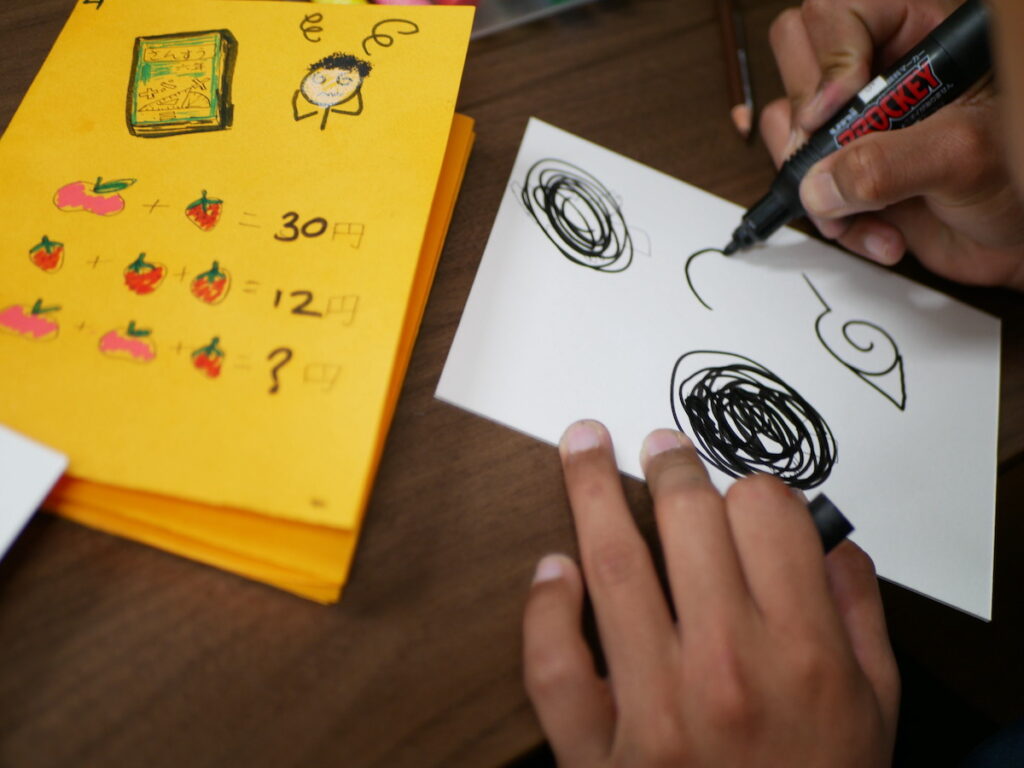
©NPO法人 芸術家と子どもたち
裏表紙を描く
Drawing the back cover.

